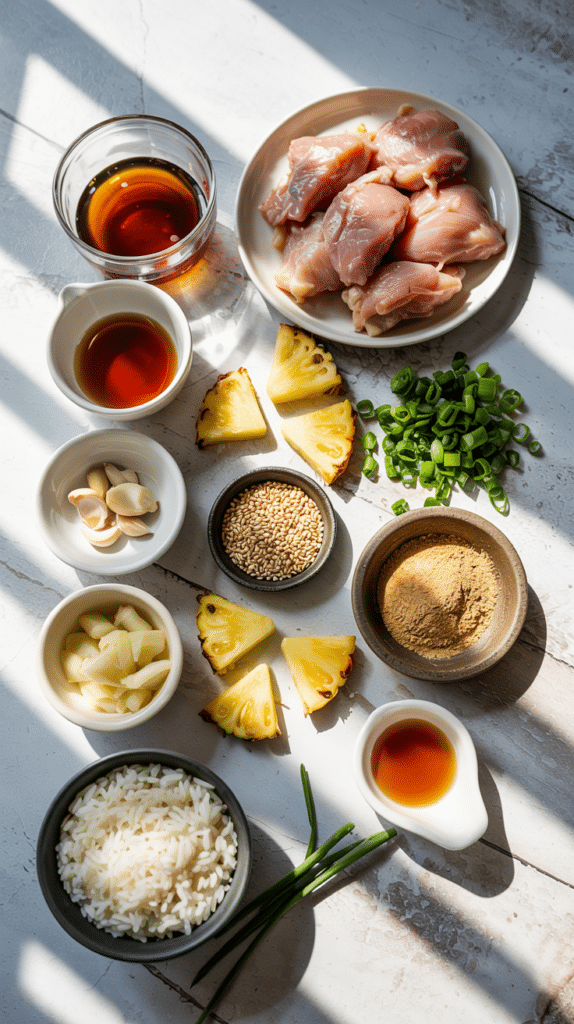Introduction & Inspiration
Craving those delicious sweet and savory teriyaki flavors but looking for a healthier, homemade option? This Healthy Pineapple Teriyaki Chicken recipe is exactly what you need! It features tender pieces of chicken (thighs or breast) marinated and cooked in a simple, flavorful sauce made with low-sodium soy sauce, honey or maple syrup, fresh ginger and garlic, rice vinegar, and sesame oil. Juicy pineapple chunks are added for a burst of tropical sweetness, creating a perfectly balanced dish.
My inspiration for this recipe comes from wanting to recreate that beloved teriyaki takeout flavor at home, but with more control over the ingredients – specifically reducing sodium and sugar while maximizing fresh taste. It’s surprisingly easy to whip up a fantastic teriyaki sauce from scratch!
This dish is perfect for a quick and flavorful weeknight dinner. It’s packed with protein, includes fruit, and pairs wonderfully with brown rice or quinoa for a satisfying and relatively healthy meal. It is a perfect dish, easy and delicious.
Nostalgic Appeal / Comfort Factor
Teriyaki chicken is a popular and comforting dish for many, often associated with Japanese-American restaurants, food courts, or easy homemade stir-fries. The combination of sweet, savory, and umami flavors is incredibly appealing and familiar. Adding pineapple brings in that classic sweet-and-savory vibe reminiscent of teriyaki burgers or tropical dishes.
This recipe delivers those comforting, familiar teriyaki flavors but in a fresher, potentially lighter format. The homemade sauce and fresh pineapple offer a vibrant taste that feels both satisfying and nourishing.
It’s a crowd-pleasing flavor profile made easy and healthier at home. A perfect dish to share with family.
Homemade Focus
This recipe emphasizes the ease and flavor benefits of making your teriyaki sauce and the complete dish from scratch. While using simple pantry staples, you’re creating a custom marinade and sauce tailored to your taste, using fresh garlic and ginger for aromatic depth.
Cooking the chicken fresh and combining it with the pineapple and homemade thickened sauce ensures a vibrant flavor that surpasses bottled sauces. You control the sweetness, saltiness, and quality of every component.
It’s about demonstrating how easily you can create a popular takeout-style dish at home with fresher, potentially healthier ingredients. The homemade difference is noticeable in the brightness of the flavors. The homemade taste is incredible.
Flavor Goal
The primary flavor goal is a harmonious balance of savory umami (from soy sauce), natural sweetness (from pineapple and honey/maple syrup), tangy acidity (from rice vinegar and pineapple), and aromatic depth (from garlic, ginger, and sesame oil).
The chicken should be tender, juicy, and infused with the marinade flavors. The pineapple chunks should be warmed through but still slightly firm, providing juicy bursts of sweetness and tartness. The sauce should thicken into a light glaze that coats the chicken and pineapple beautifully, without being overly thick or gloppy.
The overall experience should be a vibrant, balanced, sweet-and-savory dish with tender chicken and juicy pineapple, perfect served over fluffy grains. A perfect balance between flavour and texture.
Ingredient Insights
- Boneless, Skinless Chicken Thighs or Breast: Thighs are generally more forgiving and stay juicier, highly recommended here. Breasts work too but require careful cooking not to dry out. Cut into bite-sized pieces for quick cooking.
- Fresh Pineapple Chunks: Offer the best bright flavor and texture. Canned pineapple chunks (packed in juice, not heavy syrup, and drained) can be substituted for convenience.
- Low-Sodium Soy Sauce: Provides the savory umami base while allowing better control over the saltiness. Tamari can be used for gluten-free.
- Honey or Maple Syrup: Adds natural sweetness to balance the soy and vinegar. Maple syrup adds a slightly different flavor profile than honey.
- Rice Vinegar: Provides mild, essential acidity to balance the sauce. Apple cider vinegar could substitute in a pinch.
- Garlic (Minced) & Fresh Ginger (Grated): Crucial aromatics that provide signature flavor. Fresh is highly recommended over powdered for potency.
- Sesame Oil: Adds a distinct nutty, aromatic finish. A little goes a long way. Toasted sesame oil has a stronger flavor.
- Cornstarch & Cold Water: Mixed to create a slurry, this is used to thicken the sauce quickly and give it a glossy finish.
- Sesame Seeds & Sliced Green Onions: For garnish, adding texture, nutty flavor, and fresh oniony bite.
- Cooked Brown Rice or Quinoa: Healthy serving suggestions providing complex carbohydrates and fiber. White rice also works.
Essential Equipment
- Bowl: For marinating the chicken.
- Large Skillet or Wok: Ideal for cooking the chicken and combining with the sauce. Needs to be large enough to avoid overcrowding.
- Small Saucepan: For preparing and thickening the teriyaki sauce separately.
- Whisk or Spoon: For mixing marinade, sauce, and cornstarch slurry.
- Measuring Cups & Spoons:
- Knife & Cutting Board: For prepping chicken, pineapple (if fresh), garlic, ginger, green onions.
- Grater or Microplane: For grating fresh ginger easily.
Ingredients
(Serves 4)
Chicken & Marinade:
- ▢ 1 lb (450g) boneless, skinless chicken thighs or breast, cut into bite-sized pieces
- ▢ 1/4 cup low-sodium soy sauce (or tamari for GF)
- ▢ 1 tbsp honey or maple syrup
- ▢ 1 tbsp rice vinegar
- ▢ 2 cloves garlic, minced
- ▢ 1 tsp grated fresh ginger
- ▢ 1 tsp sesame oil
Sauce & Assembly:
- ▢ Reserved marinade from chicken
- ▢ 1 cup fresh pineapple chunks (or canned, drained)
- ▢ 1 tbsp cornstarch mixed with 2 tbsp cold water (slurry)
- ▢ Oil for cooking (e.g., 1-2 tsp vegetable or avocado oil)
Garnish & Serving:
- ▢ 1 tbsp sesame seeds
- ▢ 3 green onions, sliced
- ▢ Cooked brown rice or quinoa

Step-by-Step Instructions
1. Marinate the Chicken:
- In a medium bowl, combine the low-sodium soy sauce, honey or maple syrup, rice vinegar, minced garlic, grated ginger, and sesame oil. Whisk together.
- Add the bite-sized chicken pieces to the bowl and toss well to ensure all pieces are evenly coated with the marinade.
- Cover the bowl and let the chicken marinate at room temperature for at least 30 minutes, or place it in the refrigerator for up to 2 hours for deeper flavor.
2. Cook the Chicken:
- Heat a little oil (1-2 teaspoons) in a large skillet or wok over medium-high heat.
- Once the oil is hot, remove the chicken pieces from the marinade using tongs or a slotted spoon, letting excess marinade drip back into the bowl. Reserve the remaining marinade.
- Add the chicken to the hot skillet in a single layer (cook in batches if necessary to avoid overcrowding).
- Cook until the chicken is browned and cooked through, about 5-7 minutes, stirring or flipping occasionally. Remove cooked chicken from the skillet and set aside.
3. Prepare the Teriyaki Sauce:
- While the chicken is cooking (or just after), pour the reserved marinade into a small saucepan.
- Add the fresh or drained canned pineapple chunks to the saucepan with the marinade.
- Bring the mixture to a simmer over medium heat.
4. Thicken the Sauce:
- In a small cup or bowl, whisk together the 1 tablespoon of cornstarch and 2 tablespoons of cold water until smooth (this is your slurry).
- Once the marinade/pineapple mixture in the saucepan begins to simmer, pour in the cornstarch slurry while stirring continuously.
- Continue to stir the sauce until it thickens noticeably, about 2-3 minutes. Once thickened, remove it from the heat.
5. Combine Chicken and Sauce:
- Pour the thickened pineapple teriyaki sauce over the cooked chicken (either return chicken to the large skillet or combine in a serving bowl).
- Toss gently to ensure the chicken and pineapple are well coated in the sauce.
6. Serve:
- Serve the Healthy Pineapple Teriyaki Chicken immediately over bowls of cooked brown rice or quinoa.
- Garnish generously with toasted sesame seeds and sliced green onions.

Troubleshooting
- Chicken Dry: Likely overcooked. Cut pieces evenly, cook quickly over medium-high heat just until done. Using thighs helps prevent dryness. Ensure marinade time wasn’t excessively long with acidic ingredients if using breasts.
- Sauce Too Thin: Didn’t simmer long enough after adding cornstarch slurry, or slurry wasn’t measured correctly. Ensure slurry is mixed well before adding. Sauce should thicken quickly once simmering with cornstarch.
- Sauce Too Thick/Gloppy: Too much cornstarch used, or cooked too long after thickening. Whisk in a tiny splash of water or broth off-heat to thin slightly if needed.
- Sauce Too Salty/Sweet: Adjust soy sauce (use low-sodium!), honey/maple amounts next time. Taste marinade before adding chicken if unsure. Using pineapple packed in juice vs heavy syrup matters.
- Pineapple Mushy: Added too early to the sauce or cooked too long. Add pineapple to the reserved marinade just before simmering. Fresh pineapple holds up better than canned sometimes.
Tips and Variations
- Marinating Time: Even 30 minutes adds flavor, but an hour or two deepens it.
- Fresh Ginger/Garlic: Using fresh provides much better flavor than powdered versions for this sauce.
- Cornstarch Slurry: Always mix cornstarch with cold water before adding to hot liquids to prevent lumps. Stir constantly as it thickens.
- Add Veggies: Bulk up the dish by stir-frying vegetables like broccoli florets, sliced bell peppers, snap peas, or carrots after removing the chicken and before making the sauce in the saucepan (then combine everything).
- Spice it Up: Add a pinch of red pepper flakes or a dash of sriracha to the marinade for heat.
- Different Protein: This marinade and sauce work well with pork tenderloin strips, shrimp, or firm tofu. Adjust cooking times accordingly.
- Pineapple Prep: If using fresh pineapple, make sure to remove the tough core before chunking.
Serving and Pairing Suggestions
- Serve Hot: Best enjoyed immediately while the chicken and sauce are warm.
- Over Grains: Brown rice or quinoa are great healthy choices. White rice or even cauliflower rice also work.
- With Steamed Vegetables: Serve alongside simple steamed broccoli or green beans.
- Lettuce Wraps: Serve the chicken mixture in crisp lettuce cups for a low-carb option.
Nutritional Information
(Note: Estimated, per serving, assuming 4 servings, using chicken breast and brown rice. Variable based on specific ingredients, sweetener choice, etc.)
- Calories: 400-500 (without rice/quinoa)
- Fat: 10-18g
- Saturated Fat: 2-4g
- Cholesterol: 90-130mg
- Sodium: 600-900mg+ (Depends heavily on soy sauce type)
- Total Carbohydrates: 30-40g (Includes pineapple/honey/syrup)
- Dietary Fiber: 2-4g
- Sugars: 15-25g (from pineapple/sweetener)
- Protein: 35-45g
Healthy Pineapple Teriyaki Chicken: Sweet & Savory Delight
Make this quick, easy, and Healthy Pineapple Teriyaki Chicken! Features tender chicken and pineapple chunks in a simple homemade teriyaki sauce, served over rice or quinoa.
Ingredients
(Serves 4)
Chicken & Marinade:
- ▢ 1 lb (450g) boneless, skinless chicken thighs or breast, cut into bite-sized pieces
- ▢ 1/4 cup low-sodium soy sauce (or tamari for GF)
- ▢ 1 tbsp honey or maple syrup
- ▢ 1 tbsp rice vinegar
- ▢ 2 cloves garlic, minced
- ▢ 1 tsp grated fresh ginger
- ▢ 1 tsp sesame oil
Sauce & Assembly:
- ▢ Reserved marinade from chicken
- ▢ 1 cup fresh pineapple chunks (or canned, drained)
- ▢ 1 tbsp cornstarch mixed with 2 tbsp cold water (slurry)
- ▢ Oil for cooking (e.g., 1-2 tsp vegetable or avocado oil)
Garnish & Serving:
- ▢ 1 tbsp sesame seeds
- ▢ 3 green onions, sliced
- ▢ Cooked brown rice or quinoa
Instructions
1. Marinate the Chicken:
- In a medium bowl, combine the low-sodium soy sauce, honey or maple syrup, rice vinegar, minced garlic, grated ginger, and sesame oil. Whisk together.
- Add the bite-sized chicken pieces to the bowl and toss well to ensure all pieces are evenly coated with the marinade.
- Cover the bowl and let the chicken marinate at room temperature for at least 30 minutes, or place it in the refrigerator for up to 2 hours for deeper flavor.
2. Cook the Chicken:
- Heat a little oil (1-2 teaspoons) in a large skillet or wok over medium-high heat.
- Once the oil is hot, remove the chicken pieces from the marinade using tongs or a slotted spoon, letting excess marinade drip back into the bowl. Reserve the remaining marinade.
- Add the chicken to the hot skillet in a single layer (cook in batches if necessary to avoid overcrowding).
- Cook until the chicken is browned and cooked through, about 5-7 minutes, stirring or flipping occasionally. Remove cooked chicken from the skillet and set aside.
3. Prepare the Teriyaki Sauce:
- While the chicken is cooking (or just after), pour the reserved marinade into a small saucepan.
- Add the fresh or drained canned pineapple chunks to the saucepan with the marinade.
- Bring the mixture to a simmer over medium heat.
4. Thicken the Sauce:
- In a small cup or bowl, whisk together the 1 tablespoon of cornstarch and 2 tablespoons of cold water until smooth (this is your slurry).
- Once the marinade/pineapple mixture in the saucepan begins to simmer, pour in the cornstarch slurry while stirring continuously.
- Continue to stir the sauce until it thickens noticeably, about 2-3 minutes. Once thickened, remove it from the heat.
5. Combine Chicken and Sauce:
- Pour the thickened pineapple teriyaki sauce over the cooked chicken (either return chicken to the large skillet or combine in a serving bowl).
- Toss gently to ensure the chicken and pineapple are well coated in the sauce.
6. Serve:
- Serve the Healthy Pineapple Teriyaki Chicken immediately over bowls of cooked brown rice or quinoa.
- Garnish generously with toasted sesame seeds and sliced green onions.
Recipe Summary and Q&A
Summary: This Healthy Pineapple Teriyaki Chicken features bite-sized chicken pieces marinated in a homemade sauce of soy sauce, honey/maple, rice vinegar, garlic, ginger, and sesame oil. The chicken is cooked in a skillet, while the reserved marinade is combined with pineapple chunks and thickened with a cornstarch slurry in a separate saucepan. The thickened sauce is then tossed with the cooked chicken and served over grains, garnished with sesame seeds and green onions.
Q&A:
- Q: Why make the sauce in a separate saucepan instead of the skillet?
- A: This method ensures the sauce doesn’t burn while the chicken cooks and allows for easier thickening control with the cornstarch slurry without overcooking the chicken. It keeps the flavors clean.
- Q: Can I use bottled teriyaki sauce instead of making the marinade/sauce?
- A: Yes, for a quicker shortcut, you could marinate the chicken in bottled teriyaki sauce and then simply stir-fry the chicken and pineapple together, adding more sauce at the end. However, the flavor will be different, likely saltier and sweeter, and won’t have the fresh ginger/garlic notes unless you add them separately.
- Q: Is this recipe gluten-free?
- A: Use tamari instead of soy sauce and ensure your cornstarch is certified gluten-free to make this recipe gluten-free. Serve with quinoa or rice, not gluten-containing grains.
- Q: How long can I marinate the chicken?
- A: Up to 2 hours in the refrigerator is great for flavor. Longer marinating times (like overnight) with acidic ingredients like vinegar can sometimes affect the texture of chicken breast, making it slightly mushy, so keep it within a reasonable timeframe.

